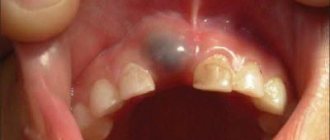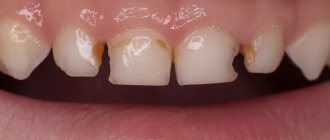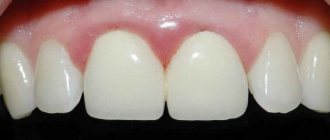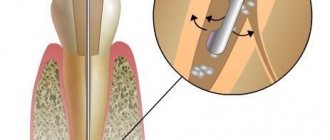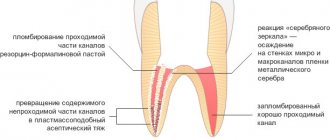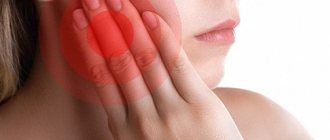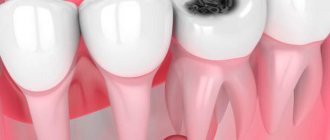Toothache is a rather unpleasant phenomenon. It can strike at the most unexpected moment. Then people wonder: what methods will help quickly relieve toothache? At the moment, there are many methods and recommendations for eliminating toothache. People use various means, both medicinal and non-traditional. This article contains the most effective methods for eliminating toothache. Pain can be caused by various reasons. However, it is worth remembering that pain relief is only a temporary measure. If there really is a problem with the tooth, then you need to contact a specialist. If you delay going to the dentist in a bad case, this can lead to tooth extraction.
You can get rid of toothache at home, for example, with the help of an ordinary painkiller. But this is only a temporary measure; very soon the symptom will appear again and even with greater force. However, many people need the tooth to go away quickly.
To forget about the unpleasant manifestation forever, you need to see a dentist and cure the disease that caused it. But, since a tooth can ache at the most inopportune moment, for example, at night, at work or while visiting, you need to have on hand means to temporarily relieve the symptom. Suitable:
- Painkillers tablets, gels, solutions. Medications will help relieve toothache at home quickly and effectively, but before using them you need to read the instructions, since almost all medications have contraindications and serious side effects. Some medications are not recommended to be taken before visiting the dentist because they interfere with identifying the cause of the pain.
- Folk remedies. They help eliminate the syndrome and are non-toxic, but less effective.
Medication assistance
Medicines can help get rid of even severe toothache, but not all types of painkillers can be used at home. Among the permitted ones are ordinary pyrazolones (Analgin), combined non-narcotic analgesics (Ibuklin, Gevadal) and non-steroidal anti-inflammatory drugs (Ibuprofen, Aspirin). Both in tablets and in gels and solutions.
Narcotic analgesics, injection medications, as well as any drugs with a large list of contraindications and side effects (Ketorolac, Ketanov) can only be used as prescribed by a doctor.
Painkillers for moderate pain
Ketorol for toothache
Paracetamol. A universal remedy that is in every first aid kit. Paracetamol does not have an anti-inflammatory effect, nor does it affect brain function - the analgesic effect is achieved by affecting pain receptors at the level of the nervous system. After taking the tablet, the pain subsides for 2-3 hours. You can take up to 5 tablets per day with a break of at least 4 hours. The higher the dosage of paracetamol, the better the effect of taking the tablet. By the way, if you suddenly don’t have pure paracetamol at hand, you can replace it with a portion of cold powder - it also contains this drug. This remedy has a minimum of contraindications: pregnancy and breastfeeding, individual intolerance to the drug. Paracetamol is also contraindicated in children under 6 years of age. The cost of tablets is on average 50-100 rubles per package (20 tablets).
Aspirin (acetylsalicylic acid) is an NSAID. Relieves moderate aching toothache. Aspirin has not only an analgesic but also an anti-inflammatory effect, specifically targeting the source of pain. You can take 1-2 tablets at a time, with the maximum daily dose for adults being 6 tablets. Aspirin is not prescribed to children under 15 years of age, pregnant women (1st and 3rd trimesters) and lactating women, patients with bronchial asthma, and allergy sufferers. Price – 50-100 rubles.
Analgin is a cheap, widely available drug available without a prescription. Works great for aching pain. Contrary to popular belief, it is forbidden to place an Analgin tablet on a sore spot, because it damages tooth enamel. Therefore, people should know not to do this. The drug is contraindicated for pathologies of the liver, kidneys, blood vessels, during pregnancy and lactation. This toothache remedy is incompatible with alcohol.
Painkillers for severe pain
Nonsteroidal anti-inflammatory drugs are used for various types of pain and successfully cope with it.
These drugs should not be taken for a long time
Ketanov (NVPS). As practice shows, Ketanov is one of the most powerful and sought-after painkillers that can soothe even the most acute toothache. The active substance, ketorolac, slows down the production of prostaglandins (hormones responsible for the feeling of pain) and has an anti-inflammatory effect. The main side effect of Ketanov is a slowdown in kidney function. Contraindications: children under 16 years of age, pregnant and lactating women, heart failure, diseases of the digestive system, kidney disease, asthma, individual intolerance to the drug. You can take no more than 9 tablets per day. The maximum duration of admission is 5 days. It is important to remember that after taking Ketanov, there may be a decrease in brain activity and a slower reaction, and therefore, after taking 1-2 tablets, you should refrain from driving. Price – from 100 rubles per package (20 pcs.).
Ketorol (NSAIDs). This is an analogue of Ketanov. The active ingredient is the same – ketorolac. Ketorol can be taken for a week, 3-4 tablets per day. The contraindications are the same as for Ketanov. The price is approximately 100 rubles for 20 tablets.
Aertal (NVPS). This is a relatively new drug that has already established itself as an excellent alternative to Ketanov. The active substance - aceclofenac - is in many ways similar in principle to ketorolac. Its clear advantage is a much smaller number of contraindications (children under 18 years of age, pregnant women in the 3rd trimester, allergies to elements of the drug). Airtal tablets cannot be considered inexpensive products at all - the price for them starts from 500 rubles per pack (20 pcs.).
What is dangerous about severe inflammation of tooth tissue?
If measures are not taken in time, the inflammatory process can lead to:
- to the formation of granulomas, cysts, abscesses;
- pulp death;
- loosening of teeth;
- removal or loss of teeth;
- spread of infection to the jaw bone (flux);
- development of general diseases, including myocardial infarction.
It is very important to start treating tooth inflammation on time, and even better, to prevent it. Many clinics provide services for the treatment of dental inflammation. It is worth choosing one that has gained a lot of experience, has its own diagnostic base, and provides guarantees for the doctor’s work.
Folk remedies
You can relieve toothache with folk remedies at home without pills. They are less dangerous than pharmacological agents, but they can cope with the symptoms of dental diseases no less effectively.
Folk remedies can be used by almost all categories of citizens
Mouth rinse
This method must be resorted to immediately after pain in the teeth appears. To improve the effectiveness of the procedure, it is necessary to thoroughly brush your teeth with a brush and toothpaste before the procedure. Solutions used for the procedure must have an antibacterial effect.
Traditionally, a soda-salt solution is used to treat the mouth. It is prepared at the rate of 1 tsp. each dry ingredient in 200 ml of boiled water. Salt inhibits the activity of pathogenic flora in the mouth, and soda helps reduce the severity of soft tissue swelling. In addition, this treatment method has practically no restrictions: it is relevant for a child, a pregnant woman or a person with allergies.
The rinsing procedure is repeated when the intensity of the pain increases or every 2 hours. The following medications are also suitable for preparing solutions:
- iodine;
- propolis tincture;
- hydrogen peroxide;
- herbal infusions (chamomile, calendula, oak).
Iodine is used as the main ingredient in an anesthetic (a few drops of the drug per 200 ml of water) or in combination with soda and salt. Hydrogen peroxide is added to water at the rate of (1 tablespoon per 1 glass of boiled liquid).
Herbal decoctions are prepared according to the traditional scheme: 1 tsp. any herbal component (or several herbs) pour 250 ml of boiling water and leave until cool (30-40 minutes).
Medicines for external use
Food and herbal ingredients are also effective in eliminating toothache, as are rinses. It is necessary to list the main folk remedies for toothache, which have long been used to combat signs of dental disorders.
Aloe. The sheet is cut lengthwise and the smooth side is applied to the inflamed gum. You can tie a plant leaf to the cheek on the side of the problem element. Relief occurs an hour after the procedure.
Propolis. The plant is thoroughly kneaded in your hands before use. The plant will have the desired effect only with slight heating (up to 36-37 degrees), otherwise there is no point in using it. The finished medicine is stored in the refrigerator and warmed in your hands before each use.
Any vegetable oils (tea, mint, eucalyptus). A few drops of oil are dripped onto the crown of the destroyed element. If a carious cavity is visible in the element, then you should try to pour liquid into this area.
To obtain the effect, it is important to follow the recipes for preparing the products correctly.
Tinctures containing alcohol or vodka. The ingredient inhibits the activity of pathogenic microorganisms in the oral cavity, thereby reducing the pain of the problem area. To combat the problem, tincture of motherwort or calendula is perfect.
Aluminium foil. This method of dealing with jaw pain is not the most popular, but it quickly eliminates unpleasant symptoms. To do this, make a narrow bridge from a sheet of foil and apply it to the inflamed gum using an adhesive plaster.
Chronic periodontitis
Chronic periodontitis sometimes develops asymptomatically, or acute periodontitis can progress to this stage. Chronic periodontitis develops when the pulp dies, and favorable conditions are created in the tooth for the development of microorganisms. Sometimes chronic periodontitis can appear after a tooth injury.
Symptoms
- Changing the color of tooth enamel
- The presence of a fistula on the gum
- Painful sensations when chewing solid food
Chronic periodontitis can have many very serious complications: granuloma, root cyst, pathological fracture of the lower jaw, periapical abscess, phlegmon and others.
Methods for quick pain relief
Sometimes the pain syndrome needs to be relieved in a short time. The following methods work most quickly:
- A sore tooth can be soothed very quickly by rinsing the sore tooth with very strong green tea with garlic. To prepare the composition, brew one and a half tablespoons of tea in a glass of boiling water and infuse for ten minutes. Then five cloves of garlic, grated on a fine grater, are added to the tea. After this, the mixture is infused for another ten minutes, filtered and the resulting liquid is rinsed with the aching tooth. It has a calming effect, and the pain disappears after the first minutes of rinsing. During the day, if necessary, the procedure can be repeated an unlimited number of times.
- Another very quick way to treat pain is to use a mixture of salt, garlic and onions. To prepare an anesthetic paste, you need to take a teaspoon of salt, garlic gruel and onion gruel. Then all the ingredients must be mixed well and applied in the required amount to the aching tooth. It is advisable to cover the top of the tooth with a cotton pad. The pain goes away within a few minutes. As in the previous recipe, there are no restrictions on the number of procedures per day.
- Rinsing with a warm solution of salt and iodine also brings relief. Take two hundred and fifty milliliters of hot water and dissolve in it one teaspoon of table salt and seven drops of iodine. Once the salt has completely dissolved, you can start rinsing. The pain usually goes away within five minutes. You can do no more than three rinses per glass per day.
- Another remedy for quick pain relief is an alcohol tincture of valerian. A small piece of cotton wool is soaked in the infusion and placed on the aching tooth. The cotton wool is changed when pain occurs again.
Sometimes the tooth begins to hurt unbearably, then these methods will be useful to the person
All of the above methods and means are only called “grandmother’s”; in fact, they are relevant in today’s world of high technologies and opportunities. However, it is important to remember: no one cancels a visit to the doctor. Even if a person does not trust or is afraid of treatment, it is necessary to obtain permission to use a particular plant, tincture or decoction from folk recipes. The reason for this is the increasing incidence of allergic reactions.
It is better not to practice heating during dental treatment at home or relying on folk experience, since the cause of trouble can be pus accumulated inside the gums or at the root of the tooth. Heating will have the opposite effect - increased pain.
Important! In general, folk remedies and ancient medicine, which is now also attributed to non-traditional medicine, cope well with the tasks assigned to them - they relieve pain, and in the early stages they treat teeth.
Why does a dead tooth hurt suddenly?
Many people believe that a dead tooth cannot hurt? But what does the expression “dead tooth” mean? This is a tooth with dead or removed pulp. Yes, due to periodontitis, the nerve dies, but remains inside the pulp, which is why it begins to decompose over time. From there, the pus goes to the root, causing the surrounding tissue to become inflamed. This is how acute pain occurs.
There are several reasons why a dead tooth becomes especially sensitive (due to complications) before and after treatment:
- Low-quality treatment and cleaning of dental canals;
- Medical violations when placing a filling: the edges of the filling extend too far beyond the root;
- Not all tooth canals have been cleaned, some of them are missed or not completed;
- Allergy to the material from which the filling is made
It is important to understand that tooth disease after treatment is a normal and natural process. It is called post-filling syndrome, which lasts for several weeks (1-2). If it really is him, then the pain will weaken every day. However, if the pain does not disappear and even increases daily, then this is a significant reason to repeat the appointment with the doctor.
SIGN UP ONLINE
Acupressure
Acupressure helps with various types of pain. However, you need to know which points affect certain parts of the body. Location of points:
- In the cavity between the phalanges of the fingers - thumb and index.
- At the base of the ear lobe on the side opposite to the problem tooth. The process of exposure is reminiscent of clamping a clip - you should hold the lobe with your fingers and hold it for a while.
- In the depression that is located between the lower jaw and cheek. Press with your thumb, a little forcefully. This simple action works very effectively, allowing you to either relieve pain completely or significantly reduce it. It works on problems that have arisen with the upper teeth.
- On the angle of the lower jaw. The impact helps relieve pain in the lower teeth.
- On the side of the index finger. You should look closer to the larger one, going down a couple of millimeters under the nail.
The technique will help not only relieve, but also completely eliminate pain. No time is required - according to Chinese medicine, you need to spend 3 minutes. It must be remembered that if a person begins to feel unwell, nausea or headache, then the impact on the points should be stopped.
Knowing how to get rid of severe toothache using your own body, a person can calmly go hiking or to the country without thinking about medications
In late pregnancy, such exposure is highly discouraged, since it is believed that it stimulates labor.
Acute periodontitis
Periodontitis is an inflammatory process in periodontal (periodontal) tissues in the area of the apex of the tooth root. Often, inflammation involves the cementum and dentin of the tooth root, as well as the alveolar bone. Periodontitis in most cases occurs due to damage to the pulp, that is, pulpitis.
Symptoms
- The pain is constant, throbbing, with clear localization
- The pain intensifies from any touch to the tooth, including when chewing
- Pain may spread to part of the face
- Headache
- General weakness
- Temperature increase
- Cheek swelling
- Pain in the gum, redness and swelling in it
- Submandibular and chin lymph nodes are enlarged
- Possible discharge of pus from the root canal
Toothache in pregnant women
During pregnancy, teeth often begin to hurt, especially if the cause is caries. During this period, it develops several times faster. During pregnancy, you should carefully choose methods for eliminating toothache. It is recommended to immediately consult a doctor if pain occurs. If this is not possible, then you can use auxiliary methods. Many people believe that pregnant women should not go to the dentist. However, it is not. If you have a toothache, you should not endure it.
Pregnant women can use all of the above folk methods for eliminating toothache. But painkillers should not be used to relieve pain, since it is recommended to avoid taking any medications during pregnancy. However, sometimes the pain is so severe that alternative methods do not help. Approved tablets and drugs that can be used only in extreme cases and with the permission of a doctor:
- Paracetamol;
- No-shpa;
- Nurofen (preferably children's syrup);
- Drotaverine;
- Lidocaine (topical only);
- Ibuprofen;
- Tempalgin (only in the 2nd trimester).
It is recommended to take these drugs for a short period of time so as not to harm the unborn child.
Important! It is not recommended to use Analgin, Ketanov, Nimesil for medicinal purposes.
Why does a tooth ache under a filling?
The filling, placed several years ago (6-7), could be pressed through and deteriorate under the influence of external factors. The tooth will hurt if the pulp is alive and the position of the filling is disturbed. Pain also occurs in the following cases:
- Pain after a short period of time after seeing a doctor is most likely a medical error, for example, the canal was not cleaned well enough, there is still an infection inside, an instrument broke during the procedure;
- Pain after a long time after seeing a doctor is a violation of the seal of the old filling.
In any case, you cannot get rid of such an illness on your own. Contact your dentist in a timely manner so as not to start an inflammatory pathological process.
General recommendations
Both medications and painkillers prepared at home will help relieve toothache faster and more effectively if you follow these rules:
- Brush your teeth regularly and thoroughly, even if these manipulations cause the tooth to hurt even more. Residues of food could have gotten stuck in the hard-to-reach interdental spaces, which triggered the onset of the symptom. But even if the reason is not related to poor hygiene, refusal to brush your teeth will lead to the active proliferation of pathogenic microflora, which is fraught with the development of inflammatory processes and increased pain;
- Do not chew food with the disturbing side. Mechanical impact on a diseased tooth will aggravate the situation, and food debris can get stuck in carious cavities, which will aggravate the inflammatory process;
- Do not heat a sore tooth. Blood will begin to flow to it under even greater pressure, which will irritate the nerve fibers and increase the pain. For the same reason, you cannot lie down;
- Don't focus on the symptom. It’s better to keep yourself busy with work, your favorite hobby, or watching an interesting movie.
Etiology and pathogenesis
The development of periostitis most often occurs with inflammatory diseases of the oral cavity and teeth, pulpitis and periodontitis. Also, the development of purulent inflammation of the periosteum can occur after jaw fractures, injuries and wounds of the soft tissues of the cheek, after treatment with anesthesia. Through damage to the dental tissue, gums or cheeks, the pathogen enters the jawbone, causing inflammation.
Acute periostitis can develop as a result of acute or chronic periodontitis, with suppuration of odontogenic cysts, and difficulty in teething. The process begins with the inner layer of the periosteum, gradually spreading to all other layers. Periostitis occurs when the focus of primary infection of the tooth canal or gum is blocked and its contents penetrate into the periosteum. The exudate penetrates through small holes in the alveolar plate through the channels.
Less commonly, flux develops in diseases of the pharynx (sore throat, pharyngitis, laryngotracheitis) or in the presence of a focus of infection in the body, from where it can be transferred to the periosteum with the blood or lymph flow.
When examining purulent contents during purulent periostitis, staphylococci (Staphylococcus aureus is one of the main causes of flux development), streptococci, various types of bacilli and putrefactive bacteria are often found.
Reference! 25% of all pathogenic microflora during flux are aerobic bacteria, the rest is anaerobic forms.
General factors influencing the development of the disease:
- weak immunity;
- hypothermia;
- stressful situations;
- poor oral hygiene;
- carious processes in teeth;
- old fillings;
- frequent medical interventions;
- bad habits.
Forms of periostitis
Depending on the cause of the flux and its course, we talk about its forms:
- Acute: simple – occurs as a result of a bruise of the face, with fractures and injuries of the jaw bones;
- purulent – penetration of periodontal infection to the periosteum;
- tuberculosis - when Koch's bacillus is carried into the periosteum and bone tuberculosis;
- syphilitic - as a complication of congenital or acquired syphilis.
- ossifying – chronic form with the development of compactions in the form of bone tissue;
Prevention
To prevent pain from overtaking you by surprise, you need to adhere to the following rules:
- Brush your teeth 2 times a day, rinse after each meal.
- Undergo a preventive examination 2 times a year.
- Consume food and water with sufficient amounts of fluoride.
- Review your diet, avoid eating unhealthy foods, as well as hot and too cold foods.
- Avoid sweets and lollipops.
These measures will be enough to provide maximum protection against toothache. If you have the slightest suspicion of changes in the condition of your teeth, you should immediately visit a doctor.
Thus, these methods are quite effective. However, do not forget that if a toothache occurs, you need to think about going to the dentist.
